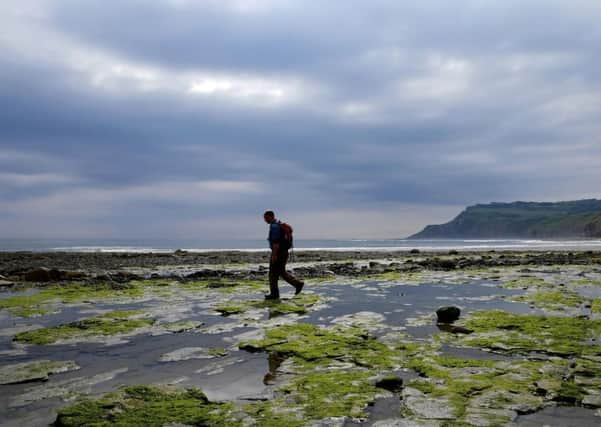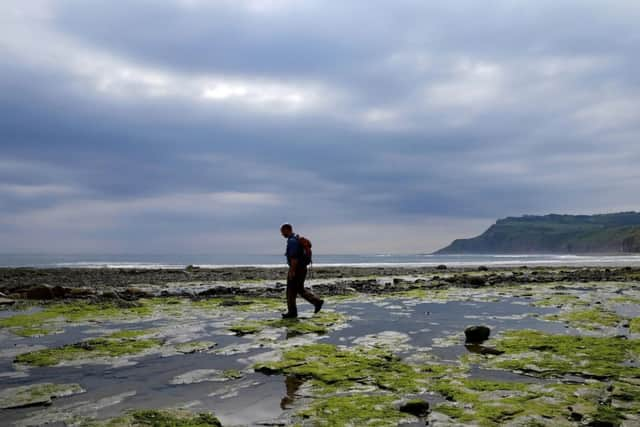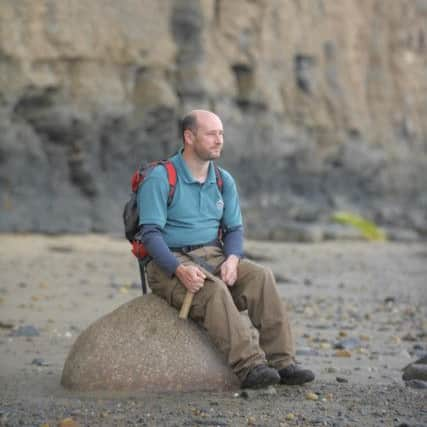Yorkshire’s east coast video special: In dinosaurs’ footsteps


IT’S a delicious time of day on the beach at Boggle Hole. But for a couple of early walkers, the world is still having its breakfast, sitting in traffic or standing at the bus stop.
Mucking about on the shoreline feels a little naughty on this Monday morning, but that only adds to the pleasure. The sky’s somewhere between grey and pink, cloud low but not threatening. In a couple of hours the greyness will burn off to reveal a peach perfect day on the Yorkshire coast, the high summer sunlight picking out the glistening edges of gentle waves. This Dinosaur Coast.
Advertisement
Hide AdAdvertisement
Hide AdBoggle Hole, the name of this coastal crevice a mile south of Robin Hood’s Bay, comes from the old name for a kind of goblin. He must have still been snoozing in his woodland lair as we tramped down the steep hill from the car park, passing Boggle Hole Youth Hostel, a refurbished mill a stone’s throw from the beach.


The dark overhanging cliff and its caves harbour echoes of centuries of smugglers who plied their trade around here.
But there are much more tangible clues to a more distant past, too. The strand beneath our feet bears the imprint of plants and creatures that existed hundreds of thousands of years ago. Yes, even dinosaurs trod heavily across this landscape.
Whitby Museum and The Rotunda in Scarborough have impressive collections of large and small geological finds from this coastline that are well worth seeing, but nothing beats finding even one fossil yourself. That’s what brings us here, braving the wrath of the Boggle as we explore his patch.
Advertisement
Hide AdAdvertisement
Hide AdThe tide is low – affording a scenic walk along the beach to Robin Hood’s Bay for early dog walkers – having shrunk away to leave the seaweed, rock pools and layers of pebbles different to how they were after the last tide ebbed 12 hours ago.


“There are only two rules,” says geologist Will Watts. “Have fun,and stay away from the cliff itself.” Rock falls of crumbling shale are a constant hazard for those who stray too close. Oh, and wear stout walking boots or wellies, as fossil-hunting can get a little slimy underfoot.
You can spend your life enjoying beaches and rockier shorelines like this without understanding anything of the fossil life that’s all around you. There’s nothing wrong with that, but knowing more about the ground beneath your feet adds a satisfying extra dimension to an afternoon splashing about and disturbing crabs.
Since going freelance last year with his company Hidden Horizons, and having spent 12 years in the museums service in Scarborough and elsewhere, Will’s mission is to bring thousands of years of geological history to life for visitors to the Yorkshire coast. In an instant – in a couple of sentences, in fact – he changed how I will view the coastline forever.
Advertisement
Hide AdAdvertisement
Hide Ad“Where we’re standing now, we’re looking at the remains of a 180 million-year-old (Jurassic period) seabed. Back then Britain was where North Africa is now. This spot was at the bottom of an ocean, and there would have been 100m of water above us.
“In the ocean were a multitude of creatures that died and fell to the bottom of the sea, including the famous ammonites included in the Whitby coat of arms. The marine creatures would have become covered with mud, which over time heated and compressed and turned into rock, preserving the flora and fauna inside.”
In the depths there was no oxygen to feed bacteria that would have fed on organic matter and destroyed the corpses. You can buy fossils from this area in shops, where experts have extracted, polished and mounted beautiful specimens for sale and will do the same for finds made by amateurs.
This is prime fossil territory, second only the the Lyme Regis area of Dorset, which is a World Heritage Site because of the abundance of finds on that coastline.
Advertisement
Hide AdAdvertisement
Hide AdAs we slowly make our way along the shore, Will stops and points out dozens of tiny fossils embedded in the surface of large rocks you’d otherwise just sit on to admire the sea. These are crinoids, or sea lilies, which are related to starfish. He picks up a small grey stone with a black print in it that’s called Devil’s Toenail.
“Let’s have a rummage,” says Will. In seconds he’s found specimens of Norwegian coral and sponge and speckled pebbles that were dragged down here by a glacier during the Ice Age 10,000 years ago.
Every item on this beach has its own story, including the orange-tinged ironstone and the rocks embedded with fossilised wood that have drifted down from Scotland over millennia. The monicker Dinosaur Coast was given to the area because remains of the icthyosaur, a dolphin-like animal, and plesiosaur have been found on this coastline. A full plesiosaur skeleton was found in Filey in 2002.
Once you get your eye in, it’s possible to pick out the fragments of solidified monkey puzzle tree we know as jet, as well pecten, a kind of scallop, and samples of the bullet-shaped belemnite. A handy book on fossils would be a useful aid to have in your rucksack – but I have Will.
Advertisement
Hide AdAdvertisement
Hide AdHe grew up inland, at Brandsdale, where his dad was a National Trust warden. He first came fossil hunting around Whitby as a birthday treat when he was a little lad, and it became a regular family ritual.
“We had a friend called Dorothy Ellison who had an infallible eye for ammonites, and I was also inspired by Peter Ensom, the keeper of geology at York Museum. I took my collection of fossils to roadshows at the museum, to confirm identification, and all this led to me studying geology at Leeds University.”
He’s now based in Scarborough, and his business works with museums and schools as well as organising independent fossil and rock pooling walks. What a great job.
A recent group were celebrating an 80th birthday, and finished off their hunt with a barbecue on the beach. “It’s become a popular celebration. I think many people are looking for more interesting things to do these days.
Advertisement
Hide AdAdvertisement
Hide Ad“The great thing about fossils is that tides mean the shoreline is changing all the time and a member of the public is as likely to find a new, previously unknown species as the expert – although the expert does spend more time systematically looking and has a trained eye.”
He says a useful method is to take a small square of pebble-covered beach, say 3ft square, and concentrate on that intensively for a good length of time, sifting through layers. He points me towards a small patch where he has already spotted something. Feeling under pressure, I scan the random collection of stones, panicking, then see one grey pebble roughly four inches long. It has a white ‘stripe’ around one side.
“Well done, that’s the one,” says Will. Out comes his hammer and a fine chisel. Holding the pebble between his boots, he gives the centre of the stone a smart crack. Without opening it he hands it to me.
I can’t tell you the thrill of that theatrical moment, as I opened up this little ancient egg of stone to see a beautiful ammonite coiled inside, a perfect spiral. “There you are, you’re the first human being to set eyes on that.” The tell-tale ‘stripe’ was part of the spine. In that ‘hey presto’ moment I understood the attraction of fossils and the stories they tell about life on earth so long ago. I am holding evidence of a sea creature that died out 65 million years ago.
Advertisement
Hide AdAdvertisement
Hide AdI wonder, though, if fossil hunting in any way damages the coastline. “I’m a big supporter of responsible collecting,” says Will. “It’s good for the science of geology, it’s a fantastic hobby, and no, it doesn’t actually damage the coastline at all.
“Obviously, people need to beware of possible dangers, staying away from the cliff – a cubic metre of rock weighs a ton, folks – but it’s great for people to discover, collect, enjoy, be inspired by fossils and tell other people about it. It helps you to understand the world about you.”
Museum staff will usually help to identify fossils, as will experts like Byron Blessed at Natural Wonders in Grape Lane, Whitby.
“Part of the excitement is that the stuff we find today would likely have disappeared in the next high tide.” As Will speaks he picks up a piece of coral from the Pennines, formed around 450m years ago.
Advertisement
Hide AdAdvertisement
Hide AdModern technology helps fossil hunting, as enthusiasts (who pursue their interest in all weathers) use phones and digital cameras to record locations and closely document the environment of a find, as well as the time and date.
Online forums are also useful for identification.
What he wouldn’t recommend is for hunters to take hammer and chisel willy-nilly to rocks in the hope that there will be fossils inside them.
I reluctantly turn towards home, pockets laden. As it sits in the kitchen, my little stone egg and its extraordinary ‘surprise’ is still evoking a sharp intake of breath every time I peep inside.
• For details of his fossil walks and to read Will Watt’s blog go to www.hiddenhorizons.co.uk